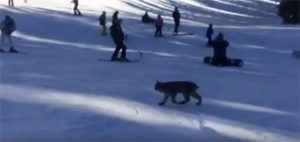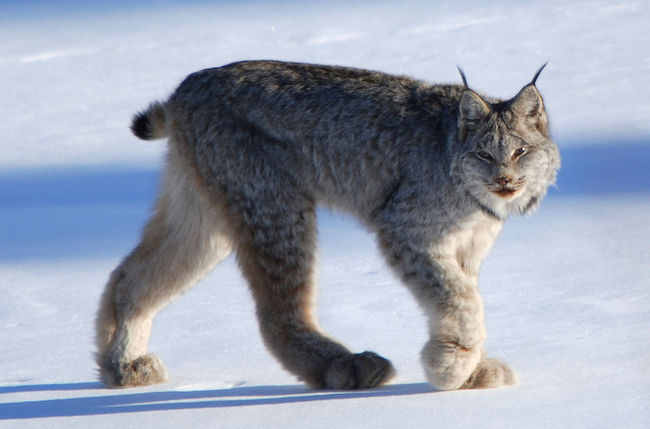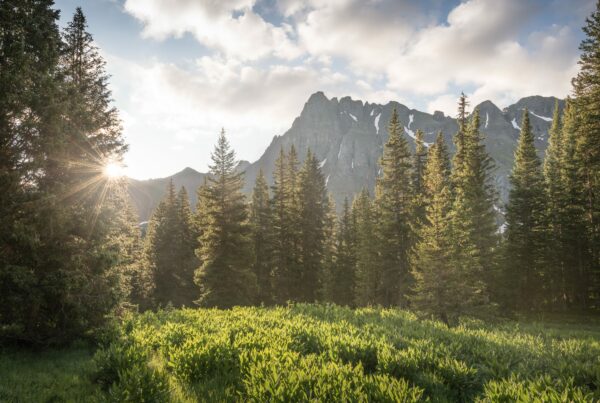By: Chris Talbot-Heindl, Communications & Membership Manager, Rocky Mountain Wild
Canada Lynx and Ski Resorts
In late December, we all watched in awe as a Canada lynx lumbered across Purgatory Resort amid astonished skiers in broad daylight. For some, it was exciting, for others frightening, and for all, very rare.

A Canada lynx lumbers across Purgatory Ski Resort
Screenshot of video taken by Airrick Hix
Lynx are elusive creatures that need a large habitat range to survive. By the early 1970’s, lynx were all but extinct from the southern Rockies due to trapping, shooting, and habitat degradation. In response to local extinction, the Colorado Division of Wildlife launched an ambitious and popularly supported reintroduction effort.
Unfortunately, a lot of the problems that caused the original local extinction have not gone away. The U.S. Fish and Wildlife Service explains that the single factor threatening lynx is “the inadequacy of existing regulatory mechanisms, specifically the lack of guidance for conservation of lynx in National Forest Land,” including high-use highways and developments like ski area expansions.
As Purgatory Resort spokeswoman, Kim Oyler, said of the lynx sighting, the resort is “prime lynx habitat.” All ski resorts are prime habitat as lynx need deep snow, younger forest with thick vegetation for hunting small prey, and older forest with a full canopy for denning – habitat that could be used to describe any Colorado ski resort.
Existing ski resorts, such as Purgatory and the minimally developed Wolf Creek Ski Area, attempt to mitigate habitat impacts to protect connectivity areas. However, mitigation has its limits.
The Village at Wolf Creek
Ever since Texas billionaire Red McCombs originally got his parcel of land in 1986 through a highly controversial land exchange, he has been trying to get increased access and circumvent the mitigation process. The original plan for the parcel was a 208-unit development, but this soon changed to a “village” with 1,711 units that could accommodate up to 8,000 people. Increased access requires Forest Service approval that must comply with many legal requirements. Attempting to game this process and shortcut regulatory protections has stalled McCombs’ ambitions in the past and Friends of Wolf Creek are highlighting current inadequacies to fight this ambitious plan again.
Friends of Wolf Creek, an alliance of concerned non-profit organizations, including Rocky Mountain Wild, San Luis Valley Ecosystem Council, San Juan Citizens Alliance, and Wilderness Workshop have challenged this land exchange decision in Federal Court. Friends of Wolf Creek allege that the U.S. Forest Service, the Fish and Wildlife Service, and McCombs again failed to comply with many legal requirements prior to approving this action.
A History of Circumvented Regulations
McCombs’ “Village” at Wolf Creek is a proposed development that would build roads, homes, condos, hotels, retail stores, restaurants, and energy infrastructure to support up to 8,000 people at the top of Wolf Creek Pass. The “village” related traffic would cut through an important wildlife movement corridor connecting the Weminuche and San Juan Wilderness areas. The traffic generated by this development would rise to levels shown to deter lynx from attempting to cross Route 160 – isolating the population to the south. Lynx that attempt to cross would have a higher likelihood of getting hit by vehicles.
The agencies involved have admitted that they don’t have an accurate number of lynx killed based on traffic on Wolf Creek Pass as it exists today. There have been no active monitoring programs. The agencies acknowledged that a number would be hard to estimate since lynx injured by cars wander off the road to die. However, the Fish and Wildlife Service made the unsupported claim that “[t]he baseline mortality rate of two lynx per six years has not been exceeded within the action area during the 14 years since reintroduction began.” This number could be a gross understatement of how traffic currently impacts the population, which obscures our ability to accurately estimate how the exponential increase in traffic would affect the species.
In 2015, the Forest Service rubber-stamped McCombs’ massive development plans by approving a land exchange that would give him a parcel adjacent to Highway 160 – an action that will be disastrous for local lynx populations when the village is built. A land exchange like this requires lynx mitigation measures that are specific, binding, solid guarantees, and a clear commitment of necessary resources to minimize impacts to lynx. Instead of these conservation commitments, McCombs penned a “conservation strategy” that defers the lynx mitigation measures until after bulldozers and construction have already devastated the landscape. The “strategy” also allows McCombs to decide what measures to implement! Somehow, this “strategy” was used to justify compliance with the statutory and regulatory requirements aimed at protecting the lynx. The agencies’ reliance on a commitment to come up with the measures at a later date violates the law and leaves the lynx populations in the southern Rockies in a vulnerable position.
The only firm part of this “conservation strategy” is a funding commitment. However, the current level of funding committed (initially capped at $850,000) will not be adequate to provide effective mitigation measures. The “strategy” calls for the construction of underpass structures that are supposed to allow lynx to cross under the highway. A 2014 study by R Ruediger et al. titled “Wildlife Habitat Connectivity and Associated Wildlife Crossings for US Highway 160, Phases II and III” specifically listed reasons why underpass structures will not be effective in this location including a “total lack of documented lynx use of the existing crossings [and] the high snow depths limiting the use of underpass wildlife crossings for four to five months of the year.” The other option to support and maintain this lynx connectivity corridor is a wildlife bridge. The current funding commitment would be entirely inadequate to construct a wildlife bridge in this location. Rocky Mountain Wild has been working to get a wildlife bridge constructed over two lanes of Interstate 70 on Vail Pass, which has a price tag in the millions.
To make matters worse, the Wolf Creek Ski Area is proposing major expansions to accommodate the increased skier capacity due to the “Village.” The Forest Service and the U.S. Fish and Wildlife Service deny that the ski area expansion and village development are related actions. This decision avoided necessary analysis of how both of these actions will cumulatively impact the local lynx populations.
Other impacts to lynx populations on Wolf Creek pass such as avalanche blasting, dispersed recreation, spruce beetle infestation, wild fire habitat destruction, and logging operations were not adequately analyzed together to determine the true pressure on local lynx populations. All these governmental failures, oversights, and neglectful management of our national resources could result in repeated local extinction of lynx in the southern Rockies.
The Bottom Line for Lynx in the Southern Rockies
The Forest Service traded away public land with valuable resources to a billionaire’s private interest, ceding responsibility of the care of those public lands, and neglecting to consider protecting a biologically rich and important part of the National Forest. The Forest Service was under no legal obligation to enable this massive “village” development or capitulate to McCombs’ wishes.
The Forest Service was under legal obligation to balance private interests with the public interest in protecting and conserving our national forest resources. The Forest Service was under legal obligation to consider and minimize the impacts to federally listed Canada lynx. The agency was required to conduct a full and transparent analysis of how the approval of the land exchange for a 1,711-unit “village” would impact one of the most critical wildlife corridors in the southern Rocky Mountains and open the analysis to public scrutiny as required by law. And that is certainly something that the public and Canada lynx both deserve.



